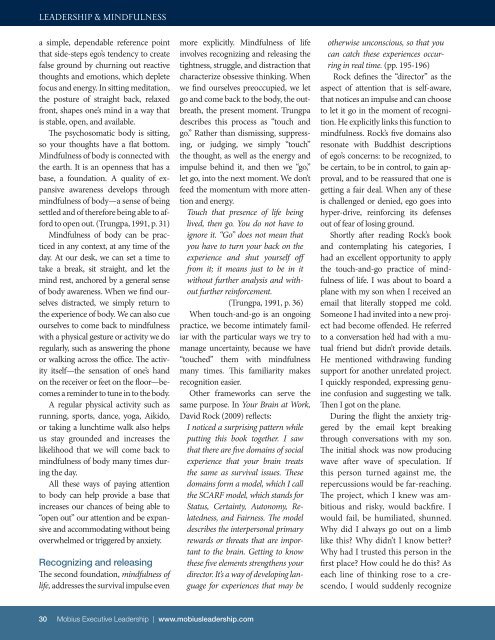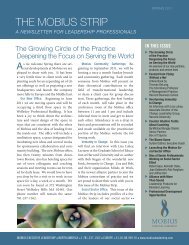Leadership & Mindfulness - Mobius Executive Leadership
Leadership & Mindfulness - Mobius Executive Leadership
Leadership & Mindfulness - Mobius Executive Leadership
Create successful ePaper yourself
Turn your PDF publications into a flip-book with our unique Google optimized e-Paper software.
LEADERSHIP & <strong>Mindfulness</strong>a simple, dependable reference pointthat side-steps ego’s tendency to createfalse ground by churning out reactivethoughts and emotions, which depletefocus and energy. In sitting meditation,the posture of straight back, relaxedfront, shapes one’s mind in a way thatis stable, open, and available.The psychosomatic body is sitting,so your thoughts have a flat bottom.<strong>Mindfulness</strong> of body is connected withthe earth. It is an openness that has abase, a foundation. A quality of expansiveawareness develops throughmindfulness of body—a sense of beingsettled and of therefore being able to affordto open out. (Trungpa, 1991, p. 31)<strong>Mindfulness</strong> of body can be practicedin any context, at any time of theday. At our desk, we can set a time totake a break, sit straight, and let themind rest, anchored by a general senseof body awareness. When we find ourselvesdistracted, we simply return tothe experience of body. We can also cueourselves to come back to mindfulnesswith a physical gesture or activity we doregularly, such as answering the phoneor walking across the office. The activityitself—the sensation of one’s handon the receiver or feet on the floor—becomesa reminder to tune in to the body.A regular physical activity such asrunning, sports, dance, yoga, Aikido,or taking a lunchtime walk also helpsus stay grounded and increases thelikelihood that we will come back tomindfulness of body many times duringthe day.All these ways of paying attentionto body can help provide a base thatincreases our chances of being able to“open out” our attention and be expansiveand accommodating without beingoverwhelmed or triggered by anxiety.Recognizing and releasingThe second foundation, mindfulness oflife, addresses the survival impulse evenmore explicitly. <strong>Mindfulness</strong> of lifeinvolves recognizing and releasing thetightness, struggle, and distraction thatcharacterize obsessive thinking. Whenwe find ourselves preoccupied, we letgo and come back to the body, the outbreath,the present moment. Trungpadescribes this process as “touch andgo.” Rather than dismissing, suppressing,or judging, we simply “touch”the thought, as well as the energy andimpulse behind it, and then we “go,”let go, into the next moment. We don’tfeed the momentum with more attentionand energy.Touch that presence of life beinglived, then go. You do not have toignore it. “Go” does not mean thatyou have to turn your back on theexperience and shut yourself offfrom it; it means just to be in itwithout further analysis and withoutfurther reinforcement.(Trungpa, 1991, p. 36)When touch-and-go is an ongoingpractice, we become intimately familiarwith the particular ways we try tomanage uncertainty, because we have“touched” them with mindfulnessmany times. This familiarity makesrecognition easier.Other frameworks can serve thesame purpose. In Your Brain at Work,David Rock (2009) reflects:I noticed a surprising pattern whileputting this book together. I sawthat there are five domains of socialexperience that your brain treatsthe same as survival issues. Thesedomains form a model, which I callthe SCARF model, which stands forStatus, Certainty, Autonomy, Relatedness,and Fairness. The modeldescribes the interpersonal primaryrewards or threats that are importantto the brain. Getting to knowthese five elements strengthens yourdirector. It’s a way of developing languagefor experiences that may beotherwise unconscious, so that youcan catch these experiences occurringin real time. (pp. 195-196)Rock defines the “director” as theaspect of attention that is self-aware,that notices an impulse and can chooseto let it go in the moment of recognition.He explicitly links this function tomindfulness. Rock’s five domains alsoresonate with Buddhist descriptionsof ego’s concerns: to be recognized, tobe certain, to be in control, to gain approval,and to be reassured that one isgetting a fair deal. When any of theseis challenged or denied, ego goes intohyper-drive, reinforcing its defensesout of fear of losing ground.Shortly after reading Rock’s bookand contemplating his categories, Ihad an excellent opportunity to applythe touch-and-go practice of mindfulnessof life. I was about to board aplane with my son when I received anemail that literally stopped me cold.Someone I had invited into a new projecthad become offended. He referredto a conversation he’d had with a mutualfriend but didn’t provide details.He mentioned withdrawing fundingsupport for another unrelated project.I quickly responded, expressing genuineconfusion and suggesting we talk.Then I got on the plane.During the flight the anxiety triggeredby the email kept breakingthrough conversations with my son.The initial shock was now producingwave after wave of speculation. Ifthis person turned against me, therepercussions would be far-reaching.The project, which I knew was ambitiousand risky, would backfire. Iwould fail, be humiliated, shunned.Why did I always go out on a limblike this? Why didn’t I know better?Why had I trusted this person in thefirst place? How could he do this? Aseach line of thinking rose to a crescendo,I would suddenly recognize30 <strong>Mobius</strong> <strong>Executive</strong> <strong>Leadership</strong> | www.mobiusleadership.com



